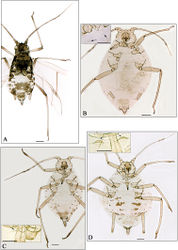Aphidura urmiensis
| Notice: | This page is derived from the original publication listed below, whose author(s) should always be credited. Further contributors may edit and improve the content of this page and, consequently, need to be credited as well (see page history). Any assessment of factual correctness requires a careful review of the original article as well as of subsequent contributions.
If you are uncertain whether your planned contribution is correct or not, we suggest that you use the associated discussion page instead of editing the page directly. This page should be cited as follows (rationale):
Citation formats to copy and paste
BibTeX: @article{Nieto2013ZooKeys318, RIS/ Endnote: TY - JOUR Wikipedia/ Citizendium: <ref name="Nieto2013ZooKeys318">{{Citation See also the citation download page at the journal. |
Ordo: Hemiptera
Familia: Aphididae
Genus: Aphidura
Name
Aphidura urmiensis Nieto Nafría & Mier Durante & Remaudière, 2013 sp. n. – Wikispecies link – ZooBank link – Pensoft Profile
Description
Apterous viviparous female (Fig. 5D). Colour in life unknown. Head yellowish brown to brown. Clypeus bigger than those of the other species of Aphidura. Antennae yellowish brown, with brown segment VI, distal 1/3 of V, and articulation between IV and V. Mesosternal mammariform processes well separated from one another, pale and round. Intersegmental sclerites small and dark brown; spiracular sclerites on segment 7 wider and darker than other abdominal spiracular sclerites; abdominal segments 3-6 with pleural and sometimes very small setiferous spinal sclerites, or with spinopleural sclerites; abdominal terga 7 and 8 pale. Siphunculi with narrow base, cylindrical (usually with slight outward curve) or slightly swollen, and as pale as tibiae. Cauda tongue-shaped, pale like genital and anal plate. Metric and meristic features in Table 4.
Types
Holotype: Apterous viviparous female (specimen 5), on Spergula marina, Shahi island, Lake Urmia (East Azerbaijan), Iran, 5-VIII-1955, Remaudière leg. (sample i962). Paratypes: 42 apterous with the same data that the holotype; plus 6 apterous viviparae on Spergularia marina, Charimboulaki, Lake Urmia (West Azerbaijan), Iran, 9-VIII-1955, Remaudière leg. (sample i004a).
Etymology
The specific name, urmiensis is an adjective that refers to lake Urmia, in feminine, from the name of the Catholic Chaldean Archdiocese of Urmia.
Discussion
The distinctive features of Aphidura urmiensis sp. n., which lives on Spergula marina are summarized in the identification key to apterae of Aphidura in the general discussion and in the following modification to key to aphids on Spergula and Spergularia (Blackman and Eastop 2006[1]) for addition of Aphidura urmiensis:
Original Description
- Nieto Nafría, J; Mier Durante, M; Remaudière, G; 2013: The genus Aphidura (Hemiptera, Aphididae) in the collection of the Muséum national d’Histoire naturelle of Paris, with six new species ZooKeys, 318: 1-33. doi
Other References
- ↑ Blackman R, Eastop V (2006) Aphids on the World’s herbaceous plants and shrubs. Volume 1 Host Lists. Volume 2 The Aphids. John Wiley and Sons Ltd. Chichester, United Kingdom, 8+1439 pp. Actualized 2013: Aphids on the World’s plants. An online identification and informative guide. http://www.aphidsonworldsplants.info [accessed April 2013]
Images
|
